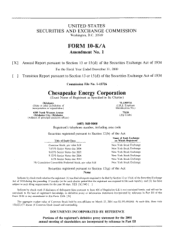Chesapeake Energy 2000 Annual Report Download - page 19
Download and view the complete annual report
Please find page 19 of the 2000 Chesapeake Energy annual report below. You can navigate through the pages in the report by either clicking on the pages listed below, or by using the keyword search tool below to find specific information within the annual report.
amount we can borrow from banks is subject to semi-annual redeterminations based on current prices at the
time of redetermination. In addition, we may have ceiling test writedowns if prices decline significantly from
present levels.
Historically, the markets for oil and gas have been volatile and they are likely to continue to be volatile.
The prices we are currently receiving for our production are near or at historic highs. Wide fluctuations in oil
and gas prices may result from relatively minor changes in the supply of and demand for oil and natural gas,
market uncertainty and other factors that are beyond our control, including:
worldwide and domestic supplies of oil and gas,
weather conditions,
the level of consumer demand,
the price and availability of alternative fuels,
the availability of pipeline capacity,
the price and level of foreign imports,
domestic and foreign governmental regulations and taxes,
the ability of the members of the Organization of Petroleum Exporting Countries to agree to and
maintain oil price and production controls,
political instability or armed conflict in oil-producing regions, and
the overall economic environment.
These factors and the volatility of the energy markets make it extremely difficult to predict future oil and
gas price movements with any certainty. Declines in oil and gas prices would not only reduce revenue, but
could reduce the amount of oil and gas that we can produce economically and, as a result, could have a
material adverse effect on our financial condition, results of operations and reserves. Further, oil and gas prices
do not necessarily move in tandem. Because approximately 91% of our proved reserves are currently natural
gas reserves, we are more susceptible to movements in natural gas prices.
Our level of indebtedness may adversely affect operations, and we may have difficulty repaying long-term
indebtedness as it matures.
As of December 31, 2000, we had long-term indebtedness of $945 million, which included bank
indebtedness of $25 million. Our long-term indebtedness represented 75% of our total capitalization at
December 31, 2000. If the Gothic merger had been completed as of December 31, 2000, our long-term
indebtedness, on a pro forma basis, would have been $1.16 billion.
Our level of indebtedness affects our operations in several ways, including the following:
a substantial portion of our cash flows must be used to service our indebtedness; for example, for
the year ended December 31, 2000, approximately 22% of EBITDA (23% of EBITDA on a pro
forma basis for the Gothic acquisition) was used to pay interest on our borrowings. We cannot
assure you that our business will generate sufficient cash flows from operations to enable us to
continue to meet our obligations under our indentures,
a high level of debt increases our vulnerability to general adverse economic and industry
conditions,
the covenants contained in the agreements governing our outstanding indebtedness limit our
ability to borrow additional funds, dispose of assets, pay dividends and make certain investments,
our debt covenants may also affect our flexibility in planning for, and reacting to, changes in the
economy and in our industry, and
a high level of debt may impair our ability to obtain additional financing in the future for working
capital, capital expenditures, acquisitions, general corporate or other purposes.
We may incur additional debt, including significant secured indebtedness, in order to make future
acquisitions or to develop our properties. A higher level of indebtedness increases the risk that we may default
on our debt obligations. Our ability to meet our debt obligations and to reduce our level of indebtedness
-8-
























